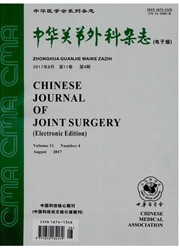

 中文摘要:
中文摘要:
目的研究阻断关节液营养对关节软骨的影响,探讨营养缺乏导致软骨损伤病理变化的潜在机制,为临床治疗骨关节炎寻求新思路。方法 45只5月龄雄性新西兰大白兔随机分为3组:保持软骨的关节液营养和软骨下骨营养组(对照组,n=15);阻断周围营养的软骨移植组(假手术组,n=15);阻断软骨的关节液营养组(DNSF组,n=15),各组动物经麻醉后用4 mm直径环钻将帽状或管状内植物植入关节软骨造模。术后4、8、12周每组5只白兔(10例膝)处死后取膝关节,进行大体评分、组织学评分、免疫组织化学染色、软骨厚度测量、凋亡染色(TUNEL)。结果与对照组相比,大体评分和组织学评分结果提示,DNSF软骨损伤明显(P〈0.0167),并且随时间延长,DNSF组软骨损伤逐渐加重;软骨厚度测量结果提示,DNSF组软骨厚度明显变小(P〈0.05);免疫组化结果提示,DNSF组二型胶原表达明减少;TUNEL结果提示,DNSF软骨细胞凋亡明显增加(P〈0.05)。结论关节液营养是保持软骨结构的必需条件;失去关节液营养后,软骨钙化层逐渐消失,骨髓血管侵入软骨直接导致软骨损伤。
 英文摘要:
英文摘要:
Objective To determine the importance of synovial fluid( SF) as the nutrition sources in cartilage degeneration. Methods Forty-five five-month-old male rabbits were randomly divided into three groups according to the sources of nutrition: the normal synovial fluid and subchondral bone marrow group( control group); the sham operation group( sham group); the depriving synovial fluid nutrition group( DNSF group). The nutrition to 4 mm-diameter cylindrical osteochondral plugs created on the trochlea of the distal femur was obstructed by polyvinyl chloride cap. The cartilage changes were assessed after four, eight, and 12 weeks by histology, immunohistochemistry, and terminal deoxynucleotidyl transferase d UTP nick end labeling( TUNEL) assay. Results The cartilage in the DNSF group suffered the greatest damage compared with the SFBM group( P〈0. 0167). Apoptosis was increased in the DNSF group compared with the SFBM( P〈0. 05) group. The cartilage was significantly thinner at all the time points in the DNSF group compared with the SFBM group( P〈0. 05). Conclusions SF-derived nutrition is the dominant source of sustenance for adult cartilage structure and function. When bone marrow becomes the main source of nutrition for cartilage,severe cartilage damage may develop due to blood vessel invasion from the bone marrow.
 同期刊论文项目
同期刊论文项目
 同项目期刊论文
同项目期刊论文
 期刊信息
期刊信息
